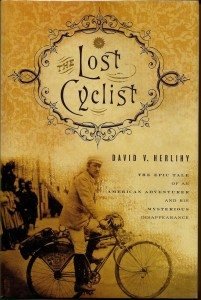‘The Lost Cyclist: The Epic Tale of an American Adventurer and his Mysterious Disappearance’
By David V. Herlihy
Boston/New York: Houghton Mifflin Harcourt, 2010: 326 pp.
Price: $26, hardcover
Once a competitive high-wheel racer, Pittsburgher Frank Lenz seemed to always finish “second-best” in the exciting world of competitive cycling, in the late 1880’s. “The opportunities for glory were limited, and the material rewards were meager,” and to the 25-year-old attention-loving Lenz, tourist cycling seemed an alluring path to accomplish something grand.

Others before him had threaded that path, touring the globe on wheels, covering vast regions, crossing towns, mountains, rivers, and even seas. Lenz was determined to cycle around the globe—armed with a camera, tripod, and the new “safety bicycle”—vowing not to board a train or boat if he could cycle or walk instead.
In the spring of 1892, Lenz began his journey, first traveling east from Pittsburgh (for a quick stop in New York, Outing magazine’s headquarters), then west across the United States, hoping to cover a distance of some 20,000 miles and 3 continents as a correspondent for the magazine. He took a steamer to Japan, and from there made his way through China, then Burma, India, across a desert into Persia, and lastly The Ottoman Empire.
Lenz never completed his journey, mysteriously disappearing in Turkey.
Outing sent another daring cyclist, William Lewis Sachtleben, to follow Lenz’s trail. Around the time of Lenz’s disappearance, “sensational reports [were] just reaching American newspapers of widespread massacres of Armenians in the very region where Lenz was bound.”
The search for Lenz’s body and evidence of the murder was almost an impossible task. However, soon Sachtleben began to receive bits and pieces of evidence and eye-witness accounts that seemed to point to a notoriously violent and cruel Kurd, Moostoe, as the main leader of an attack on Lenz.
The Armenians of the village Chilkanli said they had seen Lenz’s belongings on Moostoe. And although authorities claimed Lenz never set foot in Turkey, items belonging to the dead cyclist were carefully hidden by the village priest, Der Arsen, and other fearful Armenian villagers who had discovered the belongings on the edge of a nearby river.
“The Turks naturally tried to make much of the fact that these items were found in Armenian hands, whereas nothing was found in the Kurdish houses. But to me it was a point in the Armenians’ favor that they kept these articles which they knew belonged to the murdered man, whereas Moostoe had carefully destroyed the two pieces of the outer rubber casings, and Lenz’s revolver was not to be found anywhere,” wrote Sachtleben.
During his stay in eastern Turkey, Sachtleben witnessed a massacre that claimed 1,000 Armenian lives. “The Armenians knew well the awful intentions of the invaders, and they fled for their lives in desperation. They barricaded doors and windows and hid with their families. But the Turks and Kurds fell upon them before they had taken any steps for defense,” wrote Sachtleben. From a rooftop, he watched as attackers “burst through doors and windows and threw the inmates of the houses into the streets, where they were shot to death and brutally mutilated. The murderers were everywhere. The riflemen and swordsmen went in first to conduct their festival of murder and pillages, then the thieves followed closely behind, stripping the dead of valuables and robbing stores and homes.”
David Herlihy, the author of The Lost Cyclist, alternates between two tales: one tells Lenz’s journey, and the other Sachtleben’s. The two stories are told by stitching together newspaper articles, interviews, diary entries, and letters, amounting to a fascinating narrative that is as much a well-researched chronicle of some of the most adventuresome two-wheeled journeys around the globe, as it is a record of witness accounts to some dark pages of history.


Be the first to comment